Strategic Feeding of Spray-Dried Plasma to Reduce the Reliance on Antibiotics in Grow-Finish Pigs
Published: February 2, 2021
By: Luís F. S. Rangel, Javier Polo, Joy M. Campbell, Joe D. Crenshaw, Yanbin Shen, APC, São Paulo, BR; APC LLC, Ankeny, IA. USA.
Introduction
There is an increasing global regulatory movement to ensure the judicious use of antibiotics at farms producing milk, meat, eggs, fish, and seafood to reduce the prevalence of antibiotic-resistant pathogens that affect human health. The result of these regulatory changes will reduce the length of time antibiotics can be used, may eliminate the use of antibiotics at farms that are also used in human medicine and end the use of these products at sub-therapeutic levels for growth promoting purposes in feed. Swine producers need alternatives for antibiotic growth promoters (AGP) as health management tools that can effectively maintain the welfare and productivity of pigs while eliminating or reducing use of AGP.
For nearly three decades Spray Dried Plasma (SDP) has commonly been used in feed to help pigs transition the stressful post-weaning period (2 to 4 weeks after weaning). A comprehensive meta-analysis suggested weaned pigs provided feed with SDP have increased feed intake and growth rate, regardless of the presence or absence of AGP in feed (Torrallardona, 2010). The analysis also showed that weaned pigs provided feed with SDP has a better feed conversion ratio when AGP were absent in feed. The improved feed conversion ratio for pigs fed SDP in the absence of AGP in the feed suggests SDP could be an effective alternative to maintain the feed conversion improvement typically obtained by using AGP.
Recently, SDP has been used as a toll to contribute with the judicious use of antibiotics in grower-finisher pigs. This SDP application will be discussed in this article.
Potential of SDP in Grow-Finish Pig Feed to Reduce Reliance on Antibiotics
Lima et al. (2019), conducted a trial under commercial conditions in Brazil with 1500 grower pigs housed at 65 days of age and fed diets with either AGP or therapeutic pulses of prophylactic concentrations of antibiotics (ATP) or with SDPin various phases until slaughter (Table 1).
Table 1. Description of feed medication or SDP by treatment group and phase of experiment.
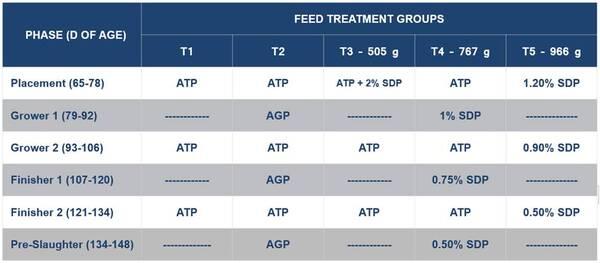
ATP = Antibiotic therapeutic pulse dose; AGP = Antibiotic growth promoting; SDP = percentage of spray-dried plasma used in feed to provide approximately 20 g SDP per day based on estimated feed intake by phase. ATP in placement feed provided 300 mg Doxyxycline/kg feed, 100 mg Tylosin/kg feed and 3 mg Ivermectin/kg feed. AGP in grower 1, finisher 1 and pre-slaughter feed provided 12 mg Flavomycin/kg feed. ATP in grower 2 feed provided 450 mg Amoxillin/kg feed, 240 mg Leucomycin/kg feed and 36 mg Abamectin/kg feed. ATP in finisher 2 feed provided,150 mg Florfenicol/kg feed. All finisher 2 feed contained 10 mg Ractopamine/kg feed. All pre-slaughter feed contained 15 mg Ractopamine/kg feed.
Pigs fed T3 had better average daily gain (P=0.01) when compared with T2, demonstrating that SDP can support swine growth without use of AGP (Figure 1). Grow-finish pigs that received SDP in combination with ATP (T4) had better feed conversion (P<0.03), versus T2 with ATP and AGP (Figure 2). Treatment5 with three pulses of SDPand T3 with a pulse of 2% SDP in the housing diet associated with ATP, but no AGP, presented about 4.7 Reais/pig or $1.20 USD/pig more incomeover feed and medical treatment cost (IOFCM)when compared to T2, the traditional medication regimen using ATP and AGP during a time with very low hog prices.T3 also presented better revenue (P < 0.01) compared with T2, T4 and T5.The authors concluded that the strategic use of SDP in feed for grow-finish pigs can be used as a tool to reduce reliance on antibiotics while maintaining similar health and performance and contribute to profitable swine production. When this trial was conducted in 2018, T3 generated 2.5% more IOFCM vs. T2 per head at a time of low hog prices. Considering the current 2020 price of hogs and feed ingredients in Brazil, T3 would generate 3.1% moreIOFCM vs. T2.
Figure 1. Average Daily Gain of pigs fed different inclusion of SDP replacing growth promoters and prophylactic antibiotics.
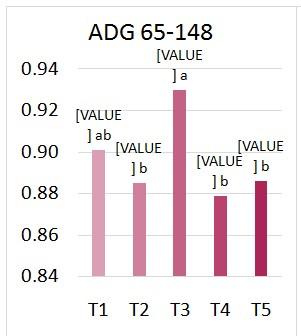
P=0.01; ADG= Average Daily Gain
Figure 2. Feed conversion of pigs fed different inclusion of SDP replacing growth promoters and prophylactic antibiotics.
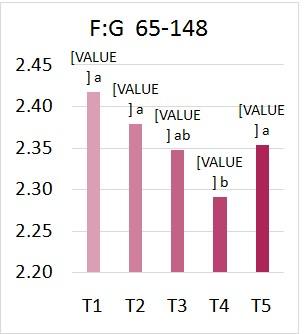
P= 0.03; F:G= Average Feed Conversion
T1)ATP without AGP or SDP; T2)AGP and ATP T3) T1 plus 2% SDP in the housing diet; T4) T1 with SDPreplacing AGP used in T2;T5) No ATP or AGP, but used SDP in placement, grower 2 and finisher 2 phases. Adapted from Lima et al., 2019.
More recently, Rangel et al. (2020)evaluated the effects of strategic use of SDPreplacing antibiotic growth promoters (AGP) in feed on health and performance of grow-finish pigs under commercial conditions in Brazil to determine if SDP can reduce reliance on antibiotics. A total of 240 grower pigs (65 d of age) were randomly assigned to either a control or SDP feed treatment group (10 pens per group). Both groups used the same therapeutic/prophylactic antibiotic (ATP) pulse program. The SDP group diets had 1.5% and 0.75% SDP formulated in the respective grower 1 and finisher 2 diets but did not include the AGP used in the control feed program (Table 2).
Table 2. Description of feed medication or SDP by treatment group and phase of experiment.
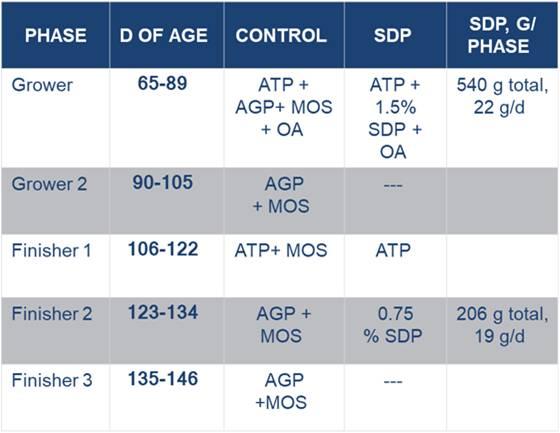
ATP = Antibiotic therapeutic/prophylactic pulse; AGP = Antibiotic growth promoting; SDP = percentage of spray dried plasma. Both groups included the same ATP program; Avilamycin 400 g/ton grower 1 and Florfenicol 350 g/ton, finisher 1. Organic acids (OA) were added at 1 kg/ton to all grower 1 diets. The SDP group had 1.5% or 0.75% SDP formulated in the respective grower 1 and finisher 2 diets but did not include AGP or MOS. Control diets included AGP; Flavomycin 100 g/ton grower 1, Flavomycin 250 g/ton grower 2, Tylosin176g/ton T in finisher 2 and finisher 3. Also, all control diets included 1 kg/ton of a MOS yeast cell wall product. All Finisher 2 and 3 diets contained 15 mg Ractopamine/kg feed. Adapted from Rangel et al., 2020.
Treatment effects on average body weight (BW), average daily gain (ADG), average daily feed intake (ADFI), feed conversion (F:G) and income over feed cost (IOFC) are shown in Table 3. Between 65 and 105 d of age, the SDP group had better ADG and F:G and higher BW at d 105 of the experiment (P<0.05) compared to the control group. Over the entire study, F:G was better (P<0.10) for the SDP group which resulted in USD 0.73/pig more IOFCcompared to the control group. These results agree with Lima et al. (2019), that also reported better performance and income using SDP to replace AGP in feed for grow-finish pigs. In both studies, strategic use of SDP in grow-finish pig feed was as effective as antibiotics, thus offering a novel approach to reduce reliance on antibiotics in accordance with new regulations for farm animals that are currently in place in Brazil.
Table 3: Performance and economic results
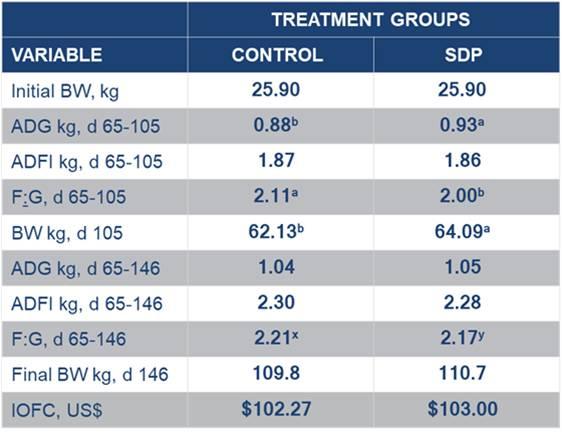
Means with uncommon superscript differ; a,b(P< 0.05); x,y (P< 0.10). IOFC = Income over feed cost. Hog price = US$ 1.27/kg live weight. Adapted from Rangel et al., 2020.
Conclusion
Strategic use of SDP in grow-finish swine feed can be a health management option for farms to reduce reliance on AGPwhile maintaining pig health and performance.SDP provides a better economic return over feed cost compared to traditional use of AGP in grow-finish feed.
References
Luís F. S. Rangel1, Javier Polo2, Joy M. Campbell2, Joe D. Crenshaw2, Yanbin Shen2
1APC, São Paulo, BR; 2APC LLC, Ankeny, IA. USA
Related topics:
Authors:
APC, Inc.
APC, Inc.
APC, Inc.
APC, Inc.
APC, Inc.
Show more
Recommend
Comment
Share

Would you like to discuss another topic? Create a new post to engage with experts in the community.










